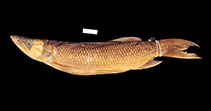| Family: |
Hepsetidae (African pikes) |
| Max. size: |
21.95 cm SL (male/unsexed) |
| Environment: |
pelagic; freshwater |
| Distribution: |
Africa: endemic to the Ogowe River basin in Gabon; known from lakes in contact with the Ogowe main channel, or in rivers close to the lakes; not recorded from the Ngounié (Ref. 93279). |
| Diagnosis: |
Diagnosis: distinguished from H. akawo and H. lineata by a narrower head width [26.4–35.6 (mean 33.1) v. 32.8–42.3 (37.0) and 32.8–46.7 (39.4)%HL, respectively] and its narrower internasal distance [15.6–23.3 (mean 20.6) v. 21.9–28.3 (24.7) and 21.5–29.3 (25.1)%HL, respectively]; both characters are positively allometric; distinguished from H. lineata by smaller number of lateral-line scales (45–51 v. 50–64) and higher number of gill rakers [17–23 v. 12–18 (exceptionally 20 in 1 specimen)]; distinguished from H. odoe by smaller number of lateral-line scales [45–51 v. 51–60 (exceptionally 49)] and smaller distance between nostril and lower jaw [33.2–40.9 (mean 38.2) v. 40.4–47.6 (43.1)%HL]; latter character is positively allometric; distinguished from H. cuvieri by higher number of gill rakers (17–23 v. 8–13), lower number of scales between dorsal fin and lateral line (8.5–9.5 v.10.5–11.5), lower number of scales between adipose fin and lateral line (5.5 v. 6.5–7.5) and longer snout [39.3–43.2 (mean 41.0) v. 35.5–38.8 (37.3)%HL]; latter character is positively allometric (Ref. 93279).
Description: elongated, laterally compressed body and narrow head with long and narrow snout; head relatively shallow; dorsal and anal fins in a relatively anterior position compared to typical position in its congeners; relatively few lateral line scales; number of gill rakers on the epibranchial of the first gill arch high (Ref. 93279).
Coloration: in alcohol: dorsal side of head and body olive greenish to brownish, with a gradual ventral change from darker to lighter tones on flanks; belly pale yellowish; sometimes with a series of 8-12 greyish vertical bands on dorsolateral parts of body; posterior part of head with 3 distinct, dark brownish bands running from posterior border of eye to anterior edge of preopercule; bands sometimes faded and poorly visible; lower half of opercule brownish, sometimes blackish; dorsoventrally rounded and elongated blackish spot posterior to head, above lateral line; pectoral and pelvic fins light yellowish, dorsal fin darker yellowish; caudal fin dark yellowish on distal part and dark orange-brown at base; posterior half of all fins, except adipose, translucent; caudal fin translucent in mid-centre and in proximal parts of both upper and lower lobes; dorsal, anal and caudal fins generally with a few small, roundish, dark brown spots; adipose-fin base yellowish-white, distal part black (Ref. 93279). |
| Biology: |
|
| IUCN Red List Status: |
Least Concern (LC); Date assessed: 28 July 2019 Ref. (130435)
|
| Threat to humans: |
harmless |
Source and more info: www.fishbase.org. For personal, classroom, and other internal use only. Not for publication.
